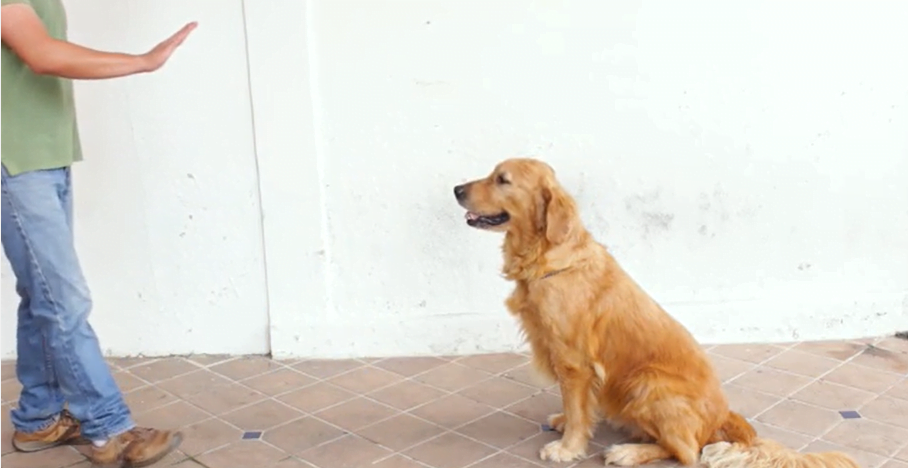首先在一个安静的地方(例如您的家或花园)进行训练,让您的狗取得成功。 让你的狗坐下 (或者躺下,如果这对他们来说更容易或更舒服的话),然后立即奖励他们一些零食。鼓励他们站起来,然后重复。当你开始离开他们时,这个阶段会奖励他们,因为你最终希望他们保持在这个位置。
让你的狗坐下来等一秒钟,然后再奖励它们一些食物。然后鼓励他们活动一下并短暂休息一下,然后再重复。逐渐增加要求它们坐下和奖励它们之间的时间,直到您的狗可以安静地坐着五秒钟。这个阶段,你仍然站在他们旁边!

现在您可以添加“停留”一词。让你的狗坐下,然后说“留下来”,等待五秒钟,然后奖励它们零食。然后鼓励他们离开并短暂休息。只说一次“留下来”,不要重复,因为您希望您的狗在一次请求后能够倾听!

逐渐增加你的狗保持静止不动的时间。一旦你的狗可以安静地坐着 10 秒钟,就开始让你在奖励他们之前要求他们保持静止的时间长度变得完全不可预测!例如,要求在奖励他们之前三秒钟,然后让他们移动,然后在奖励之前要求四秒钟,然后是两秒,然后是五秒,然后是八秒......,等等!这意味着您的狗将无法预测您需要它们保持静止多长时间,因此在您通过返回并奖励它们来明确表示之前,它们不应该开始准备移动。
如果你的狗在你奖励之前就站起来了,这可能意味着你现在要求它们保持静止的时间太长,或者你已经训练了太长时间,它们累了或感到无聊。返回一些较短的停留时间,然后完成训练或做一些您的狗熟悉并且可以做对的简单事情!保持积极态度!向你的狗表明你不开心可能会让它们感到困惑并让它们担心。

让你的狗坐下并“留下来”。只需稍微向一侧倾斜,远离他们,让他们习惯你将身体移开。回到你的起始位置并奖励他们。鼓励他们站起来走动一会儿,然后重复。
接下来,让你的狗坐下来“留下来”,这一次向一侧移动一步,然后回到你的狗身边,如果它们仍然坐着,就奖励它们。
在奖励狗之前,一定要先回到狗身边。我们希望他们觉得他们所呆的位置真的很有价值,因为这总是会导致你回来并给他们带来款待,所以他们根本不想搬家!如果你在你回到狗狗身边并且它们站起来时给它们奖励,那么你实际上是在教它们,站起来会给它们带来奖励,所以一旦你开始回到它们身边,它们就会开始站起来!小心地奖励你想要的东西,即你的狗处于你离开它们时的位置。
Gradually build up how far and in what direction you move. As with building up the duration, we want to be unpredictable, so for example, you might practice moving one step to the side, then two, then one step backward or on the diagonal, then four steps ahead. This variety teaches your dog that whatever direction you move away from them, they will still only get their treat reward for staying exactly in the position they were in when you said: “stay”.

You should now understand the principles and process of teaching your dog to stay, and they should be good at doing this within your home, so it’s time to take it on the road! When you start training, your dog may think ‘stay’ only means ‘stay’ inside the house or the garden, or wherever you’ve been practicing! You will need to go right back to the beginning whenever you start to train them in new places. But don’t worry, your dog will get quicker each time and will soon start to grasp the concept wherever you may be.
Build distractions in gradually by carefully choosing the locations you practice in and how busy they are, especially as it becomes much harder for your dog to stay still the more activity that is happening around them. Start in the garden, then an empty park, then somewhere where people/dogs are far away, then closer, and so on. You can use even tastier and extra special treats in locations that are particularly challenging for them!
You can also make distractions yourself. For example, can your dog stay whilst you roll a ball slowly (then gradually get faster), skip away, chat to someone else or go out of sight? The possibilities are only limited by your imagination and really help cement the concept of ‘stay’ to your dog. Remember, there is no need to rush! Building up the difficulty slowly and setting your dog up for success should mean your dog’s behavior is more reliable.

| 曲奇饼 | 期间 | 描述 |
|---|---|---|
| cookielawinfo-复选框分析 | 11个月 | This cookie is set by GDPR Cookie Consent plugin. The cookie is used to store the user consent for the cookies in the category "Analytics". |
| cookielawinfo-复选框功能 | 11个月 | The cookie is set by GDPR cookie consent to record the user consent for the cookies in the category "Functional". |
| cookielawinfo-复选框-必要 | 11个月 | This cookie is set by GDPR Cookie Consent plugin. The cookies is used to store the user consent for the cookies in the category "Necessary". |
| cookielawinfo-复选框-其他 | 11个月 | This cookie is set by GDPR Cookie Consent plugin. The cookie is used to store the user consent for the cookies in the category "Other. |
| cookielawinfo-复选框性能 | 11个月 | This cookie is set by GDPR Cookie Consent plugin. The cookie is used to store the user consent for the cookies in the category "Performance". |
| 查看的_cookie_政策 | 11个月 | 该cookie由GDPR Cookie Consent插件设置,用于存储用户是否同意使用cookie。它不存储任何个人数据。 |
在继续您的收养申请之前,请查看并接受我们的数据处理惯例:
笔记: By clicking "I Agree & Continue", you will be redirected to an external application form. This tracking system logs your interest but does not capture data from the external form.